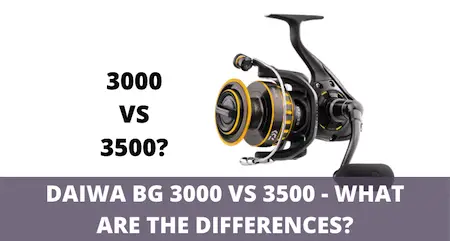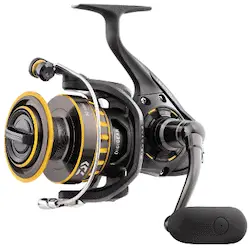Daiwa BG 3000 Or 3500 – What Are The Differences, And Which One Should You Buy?
UPDATED 15 MAY 2023
by Robert Ceran
This article may contain affiliate links. If you make a purchase after clicking on a link we may earn a small commission at no extra cost to you.
The Daiwa BG 3000 and 3500 size reels are great medium sized spinning reels that are ideal for either medium freshwater applications, or lightweight saltwater applications.
If you’re thinking about getting one of these sizes, it’s useful to compare their exact specs, in order to understand what distinguishes them from each other.

For this article we tested both sizes side by side, and discuss their most important differences.
Daiwa BG 3000 vs 3500 – what are the differences?
The table above compares he specs of both reel sizes that we tested next to each other.
As you can see from the table above, even though they are very close to each in terms of size classification, there are actually big differences between them.
Now let’s dive into the details and take a closer look at their most important differences revealed by our testing.
Most important differences between Daiwa BG 3000 and 3500
The BG series covers a wide range of sizes from 1500 to 8000, and according to their size classification, both of these reels should be relatively small models at the lighter end of the scale (for more details on this, take a look at our guide on spinning reel sizes).
Weight: This is the first area with a big difference between the two sizes. At 14.10 oz, the 3500 is a whopping 30% heavier than the 3000.
This is a clear indication that they are not just slight variations of each other, but very distinct models.
In fact, upon closer inspection, it turns out that the 3500 is much more similar to the 4000, and those two sizes are basically the same model with different spool sizes.
Bottom line: Based on our testing, there’s a big size difference between the two sizes, and the 3500 is basically a slightly downsized 4000. So if you want to get a reel for a more lightweight application (such as bass or walleye fishing), then you should definitely choose the smaller one.
On the other hand, if you are looking for something heavier (for catfish, muskie, or saltwater spinning, for example), then the bigger one is the right choice for you.
Drag system: The 3500 has a more powerful drag system, with up to 17.6 lb max drag pressure, while the 3000 only goes up to 15.4 lb.
Similar to the situation with the weight, the drag pressure of the 3500 is identical to that of the 4000, confirming that it is actually a slightly downsized version of the 4000.
Bottom line: When we put it to the test, we found that the drag of the 3500 is significantly stronger than that of the 3000, making it the better choice for heavier applications targeting bigger fish.
Line capacity: This is another area with clear differences between the two sizes. The spool of the 3500 can hold 20% more line of the same pound test, which confirms our observation that it is a much bigger and stronger reel.
Bottom line: The 3500 has 20% more line capacity, and is better suited for stronger pound test line if you’re planning to target big fish.
Retrieve rate: There is just a small difference between the two sizes in this category, and both of them are very fast reels, with 37.4” and 38.5” retrieve rate, respectively.
Gear ratio: This is another category with just small differences. Both reels have an almost identical gear ratio of 5.6:1 and 5.7:1, respectively. This is a relatively fast ratio, and part of the reason why they have such a high retrieval rate.
Overall, there is a much bigger size difference between the two models than is suggested by their size classification, and you have to be aware of this when you make your decision which one to buy.
Daiwa BG spinning reel reviewed


This is the most popular spinning reel series sold by Daiwa, and provides incredibly high value at a competitive price point just above the $100 mark. In fact, this model includes some of the same technology used in more expensive high-end Daiwa models, including their ball bearings and gear system.
During our testing we found that the 6 plus 1 ball bearings make this a very smooth reel, and the oversized digigear system gives it extra torque and power when cranking in big fish.
The metal frame is made with anodized aluminum, which is highly resistant to oxidation and results in greater durability.
The air rotor is significantly lighter than regular rotors, and contributes to the fact that these reels are on average lighter than similarly sized competitor models.
When we put it to the test we found that one of the most impressive features of this series is the extremely high retrieve speed, which is among the highest available on the market.
Based on our testing, this makes it an ideal choice for high speed spinning methods for pelagic species such as striped bass, mackerel, and kingfish.
The extra speed of the BG is only partially due to having a high gear ratio. Most of it is actually achieved with the increased diameter of the ABS spool, which is designed to hold more line and to release it with less friction, which also improves casting distance.
Features:
- Anodized aluminum frame and sideplate
- Braid ready spool
- Lightweight air rotor
- ATD carbon fiber drag
- Anti reverse switch
Daiwa BG 2500 vs 3000
The Daiwa BG 2500 is significantly smaller than the 3000, which is most apparent when you compare their line capacity.
While the 3000 holds 240 yards of 8 lb test mono, the 2500 only holds 170 yards of 8 lb test mono. This is due to a smaller spool size, which also explains why the 2500 has a slower retrieve rate of 33.2 inches per turn of the handle (as compared to 37.4 for the 300).
So all in all, the 2500 is much smaller than the 3000, and thus makes a better lightweight spinning reel for smaller fish (such as trout or perch) or for finesse applications.
Daiwa BG 3500 vs 4000
The main difference between the Daiwa BG 3500 and 4000 is the size of the spool, which results in 40% more line capacity of the 4000 vs the 3000. In all other regards, these two reel sizes are almost identical. In fact, since they are so similar to each other, Daiwa has talked about replacing the 3500 entirely with the 4000, although at this time you can still get both of these sizes.
Conclusion
This reel is one of the best models on the market, which is why we included the Daiwa BG in our shortlist of the best spinning reel under 100.
So if you’re thinking about getting a new BG reel, the next question is: which size should you get?
To summarize, our testing revealed that the 3500 has the same body as the 4000, but comes with a slightly smaller spool size. Because of this, during our testing we found that it is a much heavier reel than its size classification suggests, and makes an excellent inshore saltwater reel for striped bass, snook, and jacks.
The 3000, on the other hand, is a significantly smaller fishing reel, and is much better suited for lighter applications, such as bass or walleye fishing.
Methods and gear used for testing
For consistent testing results, we tested each of these spinning combos under the same conditions in Tampa Bay. We spooled each spinning reel with 10 lb test Suffix Siege monofilament line, and we tested them with 1/4 to 3/4 oz swimbaits in 8 to 41 feet of water.
